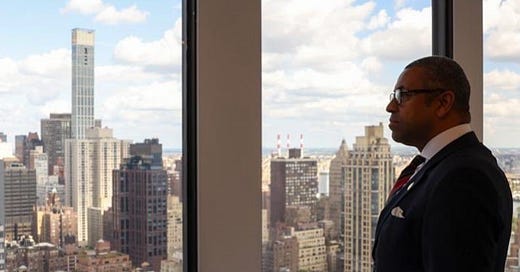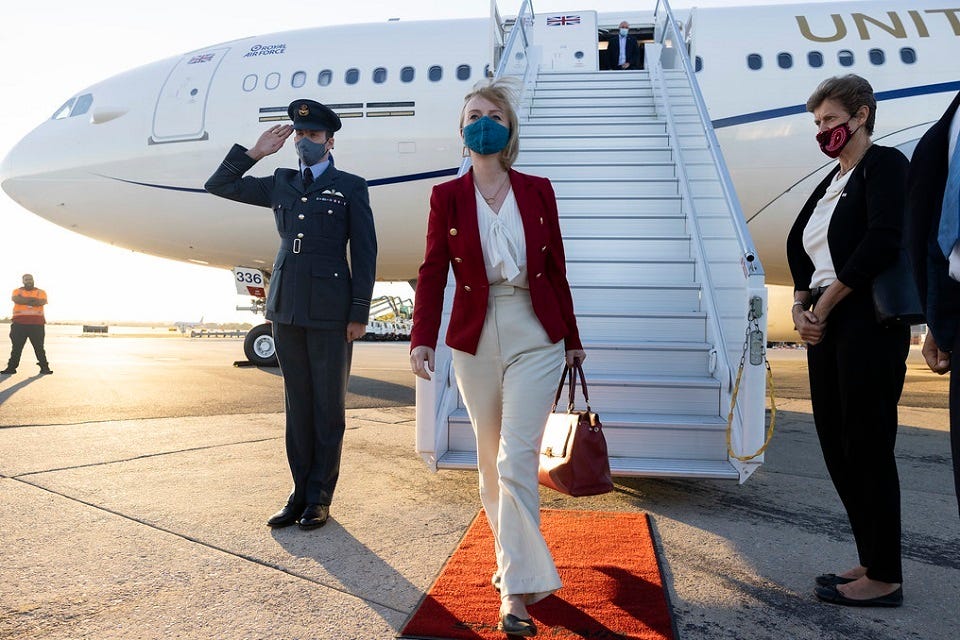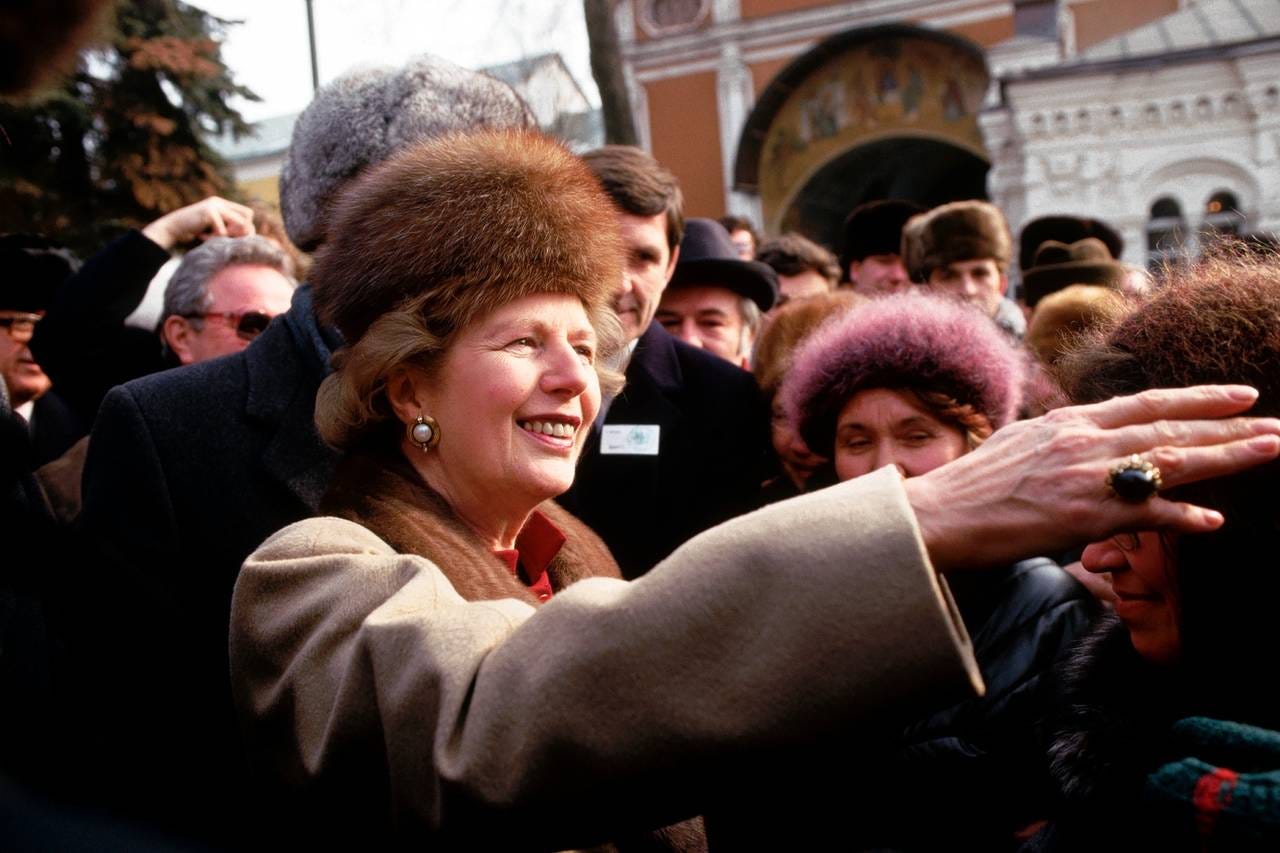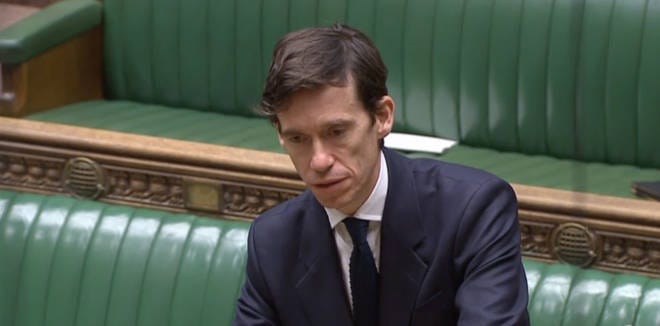All the world's a stage: from the Foreign Office to Downing Street
It has become rare for prime ministers to vault directly across the street from the Foreign Office, but why isn't it a good path to the top job?
When James Cleverly was appointed secretary of state for foreign, commonwealth and development affairs in September, the department’s Instagram account sprang into action with its usual verve and style. One of the earliest images was of the new foreign secretary, above, in New York for the 77th session of the General Assembly. I confess I thought instantly it was a masterpiece. It is carefully framed to show Cleverly looking out over the city, pensive and statesmanlike, and the message was as clear as a bell: here is a man fit to occupy the world stage, to talk on equal terms with other global leaders, and occupied in the kind of deep thought which we like to associate with the conduct of foreign policy. He is a smartly dressed man anyway, and he looked the part: well cut suit, striped tie (though not his favoured regimental item; he is a lieutenant colonel in the Royal Artillery reserves) and pocket square.
It was a superb move. Cleverly came to the Foreign Office with barely a year’s experience in cabinet, though he had been a junior minister at the FCDO for more than two years, and needed to be presented as a substantial and credible figure. The photograph did all that, with deft visual shorthand. It might be a stretch to say that this image meant he stayed in office when Rishi Sunak took over the premiership, but it was certainly the sort of depiction which would have reassured. Another reminder, for those who mock, that social media is now not only unavoidable for government but a powerful tool in the communications armoury.
Liz Truss, who appointed Cleverly to the high office, did something which no-one had done since the time of her birth: she went from foreign secretary directly to prime minister. (Boris Johnson had been a notably haphazard and sub-par foreign secretary from 2016 to 2018 but had resigned and seized the premiership from the backbenches.) James Callaghan had been the last politician to make the move, in 1976, and before that only Sir Alec Douglas-Home (1963) and Sir Anthony Eden (1955) had used the Foreign Office as a direct springboard since the Second World War. (Before them you have to look back to 1894, when the Liberal foreign secretary the Earl of Rosebery was chosen as prime minister).
This is, at first glance, peculiar. The Foreign Office is, after all, regarded as one of the four “great offices of state” (along with the premiership, the Treasury and the Home Office), and has been held by some of the most resonant names in modern politics: Salisbury, Balfour, Curzon, Bevin, Callaghan, Howe. I wrote a few days ago of the Home Office’s reputation as the “graveyard of careers”, but what is it in the nature of the Foreign Office which potentially acts as a disadvantage? It is a venerable as well as an important office, founded in 1782 when the Northern and Souther Departments were transformed into the Foreign and Home Offices. It has pedigree.
Many foreign ministries are perceived as set apart from other institutions of government. The US Department of State (known metonymically as Foggy Bottom) is the most prestigious part of the federal government beyond the White House; the French Ministry of Foreign Affairs (colloquially the maison Quay d’Orsay) was traditionally led by well-born diplomats who came from families which had served the department for generations; while the German Federal Foreign Office derived much prestige from the frequent status of its minister as vice-chancellor in coalition governments. The opportunity to work around the world, rigorous selection processes and the importance of language skills tend to create the image of an elite corps.
This has always applied to the Foreign Office here. (It has gone by a number of names: the Foreign Office from 1782 to 1968, the Foreign and Commonwealth Office from 1968 to 2020 and since then the Foreign, Commonwealth and Development Office; for clarity I will generally use the simple Foreign Office.) The Diplomatic Service is recruited and led separately from the Home Civil Service, which is now generally headed by the cabinet secretary, and, while cross-departmental appointments are more common today, most FCDO personnel can still expect to spend most if not all of their careers in the department. Competition is fierce: in 2018, there were 12,266 applicants through the Fast Stream for just 71 positions, 0.6 per cent of the candidates. It has also lagged behind the Home Civil Service on several measures of diversity. Women were not admitted in any grade until 1946, and until 1973 female diplomats were required to resign if they married. The first female ambassador was Anne Warburton, appointed ambassador to Denmark in 1976.
The Diplomatic Service has also had a reputation as a self-perpetuating social and educational elite. As recently as 1965, the pioneering political analyst Anthony Sampson described it as a “pseudo-aristocracy, bound together by their Oxbridge background; by the intimacy of Third Rooms; by the perpetual round of embassy parties”. Salaries were only introduced across the board in 1919, and in 1943 the department made a slightly plaintive and defensive commitment to recruit from “any social sphere”. Only three years ago, a study of educational backgrounds in the public sector revealed that just over half of the service came from fee-paying schools, and a similar proportion had attended Oxford or Cambridge. A symbolic episode came in 2015 when the permanent under-secretary of state and head of the Diplomatic Service retired: in a masterstroke, the Foreign Office managed to replace a white, middle-aged Cambridge graduate called Simon with a white, middle-aged Cambridge graduate called Simon (Fraser and McDonald). The current permanent secretary, Sir Philip Barton, is a Warwick graduate, the first non-Oxbridge man (a woman has never headed the service) for 30 years.
In truth, diversity has more often come from the political heads of the Foreign Office in the past 50 or 100 years than from the civil servants. Although there has been a strong tradition of aristocratic or at least gentlemanly foreign secretaries—Balfour, Curzon, Eden, Halifax, Home, Carrington, Hurd—there have been two female occupants (Margaret Beckett and Liz Truss), and one of the most popular, effective and cherished foreign secretaries within the department itself was Ernest Bevin, the West Country trades union leader who had left school at 11 and read only with some difficulty. Although it was said that he could only have held two positions within the Foreign Office, secretary of state or lift attendant, he was tough negotiator and a protective departmental head. His first permanent secretary, the impeccably upper-class Sir Alexander Cadogan, wrote “He knows a great deal, is prepared to read any amount, seems to take in what he does read, and is capable of making up his own mind and sticking up for his (and our) point of view against anyone.”
Matters are improving. Successive permanent secretaries have made public commitments to improve diversity across the board, and almost all of the most senior diplomatic postings overseas are held by women: Washington, the United Nations, Paris, Beijing, Moscow, Canberra, Berlin, Ottawa and Tokyo. It seems at least likely, therefore, that the next permanent secretary will be female.
Although it has long been seen as a Rolls-Royce of a department, staffed by rigorously selected, highly qualified civil servants, the current reputation of the FCDO is not high. The 2020 reabsorption of the Department for International Development—which was created from the Ministry of Overseas Development and made independent of the Foreign Office by Tony Blair in 1997—is still not complete, and internal divisions remain in terms of information technology, culture and other aspects of working life. A report by the Institute for Government, an astute and insightful observer of Whitehall ways, written by Tim Durrant and Jordan Urban, highlighted a catalogue of weaknesses and failures. Morale is low, not least because several critical functions have been transferred to the Cabinet Office and the National Security Council, the mindset of the department has become insular since Brexit, despite the promise of the government’s frustratingly diffuse Global Britain strategy, and in many cases resources are poorly allocated: 460 full-time staff are working on policy for the Indo-Pacific region, while just 160 in a single unit address Eastern Europe and Central Asia, despite the ongoing conflict in Ukraine. It must also be a distraction from consolidation and reform that we have had five different foreign secretaries in the last five years.
Institutional and systemic weaknesses alone cannot explain why the Foreign Office does not often supply candidates for the premiership. There is also the nature of the work itself. One is a simple fact of political life. Unless there is a major and ongoing crisis, the foreign secretary is rarely at the forefront of the public’s consciousness. The electorate’s priorities are almost entirely shaped by economic and domestic policy—the cost of living, taxation, healthcare, law and order and so on. Britain’s standing in the world and its relations with foreign countries and multilateral organisations like the United Nations and NATO are rarely in the headlines or on the public’s mind. That has not been the case in the past few years, with first Brexit and then the conflict in Ukraine, which may be one reason why Liz Truss, as foreign secretary, was a leading candidate to replace Boris Johnson in Downing Street.
(It is worth noting, in relation to Brexit, that in the wake of the referendum in 2016 and the decision to leave the European Union, the Foreign Office was largely excluded from the consequent withdrawal negotiations. Theresa May, when she succeeded David Cameron as prime minister, created the Department for Exiting the European Union, DExEU, combining the Foreign Office’s Europe directorate, the Europe Unit from the Cabinet Office and the UK Permanent Representation to the European Union. Although DExEU survived until the UK’s formal departure from the EU in January 2020, its existence and operation was not universally regarded as a success.)
The foreign secretary also has a distinct role which weakens his or her purely political hand. The departmental head must, by necessity, undertake a great deal of international travel, which removes them not only from the political front line but also, crucially, from the corridors and tea rooms of the House of Commons. The phrase “out of sight, out of mind” is brutally applied in British politics, and any senior politician who does not do the social rounds and listen to colleagues’ opinions will not easily develop a personal following. Backbenchers have an acute sense of personal dignity and importance, and if they are not assiduously courted, they will find other standards to rally round.
In the rare situation that foreign affairs do take a prominent part in the public consciousness, the foreign secretary will also find himself or herself fighting for the limelight with their leader. Prime ministers quickly come to understand that gracing the world stage is more glamorous, and often less demanding, than dealing with the humdrum issues of everyday life at home. Margaret Thatcher understood this very acutely, and, for example, made a groundbreaking visit to Moscow in March 1987, a few months before the general election which delivered her third consecutive win. Being filmed and photographed in a Russian fur hat, meeting face-to-face with the new Soviet leader Mikhail Gorbachev, contributed more to her image as an important global figure than any number of UK visits could have done.
There is also a fundamental truth that much of foreign affairs is a matter of detailed and impenetrable negotiation and messy compromises rather than clear-cut, media-friendly victories. Brussels was particularly heavy on verbiage and unreadable communiqués during the UK’s membership of the EEC/EU, and while a foreign secretary might have to repeat carefully nuanced and tortuously agreed formulations of words to respect international agreements, a prime minister is freer to paint the canvas in broad strokes, more suitable for the media soundbite or the newspaper headline. There are exceptions. Lord Carrington, Thatcher’s first foreign secretary, successfully chaired the Lancaster House conference which took renegade Southern Rhodesia from white rule to independence as Zimbabwe, and was rightly lauded for his efforts. But his successor, the über-wet but highly able Francis Pym, went unheralded for his frantic and exhausting shuttle diplomacy during the Falklands crisis in 1982 than did Thatcher and her defence secretary, John Nott, when the conflict was won by feat of arms.
Many politicians aspire to run the Foreign Office. When A.J. Balfour, the former prime minister, was offered the post of foreign secretary in 1916, he sighed, with typical languor, that the prime minister put a revolver to his head, and so he must accept. Lloyd George, the new premier, responded sharply that there were never enough to revolvers to go round. Equally, Stanley Baldwin, the Conservative leader through the 1920s and 1930s, complained that every cabinet contained 20 foreign secretaries, but only one minister of labour. The attraction is easy to see: the UK’s chief representative abroad is a substantial figure who will meet and mingle with world leaders and attend high-level conferences and summits. He or she will travel to exotic locations in some comfort (though the cost of travel is coming under increasingly parsimonious scrutiny), and will have glamorous photo opportunities. For some reason, our political community sees discussing global relations or abstruse conflicts as more sophisticated and grown-up than housing, transport or social care provision.
(Rory Stewart, a man whose CV could have been designed to culminate in the post of foreign secretary, is a rare dissenter in this matter. He has spoken with disillusion and disenchantment of the experience of answering questions at the despatch box as a Foreign Office minister, reading out prepared and bromidic answers to barely informed questions. He was, counterintuitively, much more enthusiastic about his tenure as environment minister from 2015 to 2016 and prisons minister from 2018 to 2019. The reason for this, he explained, was that he derived satisfaction from tangible results and a high degree of operational control rather than the nebulous influence enjoyed by ministers at the FCO.)
Perhaps aspirant foreign secretaries should be careful, then. They are statistically unlikely to ascend to the premiership (though Macmillan, Major and Johnson had held the office briefly some time before they moved to Downing Street) and they may find themselves marginalised in the hard-bitten arena of domestic and party politics. For some whose ambitions do not extend to the very top, that may not be a disincentive: Carrington knew that, as a peer, he would never be prime minister and therefore regarded foreign secretary as the pinnacle of his career, while Douglas Hurd, though he stood for election as leader in 1990, was a former professional diplomat and seemed most at home when he became foreign secretary and a senior cabinet minister without further aspirations. But most MPs have at least considered themselves as national leaders, and they might find that other senior offices will deliver a greater return of political capital.
One final thought. The notion of the great offices of state derives from the key positions in the Royal Household which adhered around the sovereign and then formed the nucleus of the emergent cabinet, originally a sub-committee of the Privy Council. It is understandable that these offices addressed the administration of finances and executive power at home and abroad. But there has been no revision of what we call the great offices of state since the idea of a “prime minister” evolved at the beginning of the 18th century. Yet the roles which make up the quartet—all four of which have only ever been held by Jim Callaghan—have changed and developed with the vast expansion of government functions and duties over the last three centuries. The Home Office, for example, which sprang from the reorganisation of the Southern Department in 1782, accreted a huge number of responsibilities and then slowly shed them as issues like education, housing and local government gained their own departments. It was then radically slimmed down in 2007 when it lost prisons, courts and probation to the new Ministry of Justice.
We now have enormous, high-spending departments like Health and Social Care, Work and Pensions and Defence which make a huge contribution to political life and society. Are these to be excluded from “great office” status simply because of the organisation of executive functions in the early 18th century? Or should we try to rethink the concept of the great offices, recognising values like budget, reach and headcount as well as venerability and former proximity to the crown? I do not know how we would do it, and I certainly don’t suggest that we put the great offices of state on a statutory footing or anything so revolutionary; but we ought to consider whether they distort our view of governmental priorities and the weight we should afford to leading politicians. Answers on a postcard, please…








